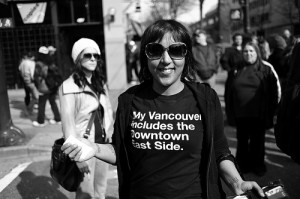
Image taken from http://www.insidevancouver.ca/wp-content/uploads/2011/10/DTES.jpg
I have been working at the Downtown Eastside Neighbourhood House for the past few weeks serving food during the lunchtime drop in. I am realizing that it is not an easy place to be. Even before I moved to Vancouver, people constantly reminded me of the notoriety of the area as a place where Vancouver’s most destitute come to reside. I have never really been able to take these warnings seriously; most remind me of children’s stories of Bogeymen and Demon Ghosts, tales to keep us away from the fire, stories that demonize the poor and dig deeper lines of separation between people. Although I recognize a lot of the rhetoric of fear and loathing as largely unfounded, I cannot help but feel a sense of discomfort when interacting with people at my field site. Anthropology recognizes that any interaction between researcher and participant will inevitably influence data that is collected. As Burawoy describes, these contextual effects can be highly informative and offer new lines of insight. Therefore, I have tried to use these moments of discomfort in my interpersonal interactions to inform my research and better understand the dynamics of community in the area.
I can be very shy and passive and I am absolutely terrified of conflict, which has made it difficult for me to maintain dialogue and has distanced me from the people I am working with. Sometimes however, the few verbal interactions I have had with people end up pushing me to be more aggressive, particularly with men. I have had guys ask, “hey gorgeous, are you on the menu?” and I feel disgusted and angry. I have to calm the urge to tell people to eff off. I must be polite, calmingly Canadian polite. Except that one time someone asked if I would sell him my panties. Gut response got the best of me, “fuck off, no.” I am constantly at one extreme or the other, fight or flight, afraid or aggressive, because people are constantly transgressing my personal boundaries either intentionally or unintentionally. Even speaking to women is difficult because many of them are themselves being aggressive or defensive, perhaps for the same reasons I am behaving this way. Within the neighbourhood house itself, these experiences and interactions have meant that I try to be as passive of an observer as possible and focus on interviewing volunteers rather than community members. Although not the ideal way I would like to interact with people, I have to concede to my own limitations and discomfort and try and find ways to work with what I have.
The DTES is not the demonic hell hole that people constantly depict it as; there are nodes of community that certainly do exist and the DTES Neighbourhood house is one such venue. Although my interactions with people in this community are limited by my discomfort, I am using these interactions to inform my analytical approach and further explore how they might reflect deeper issues of community building and belongingness. I try to keep in mind Burawoy’s assertion that any sort of intervention between researcher and participant, even from the most passive observer, can be both informative and insightful.
